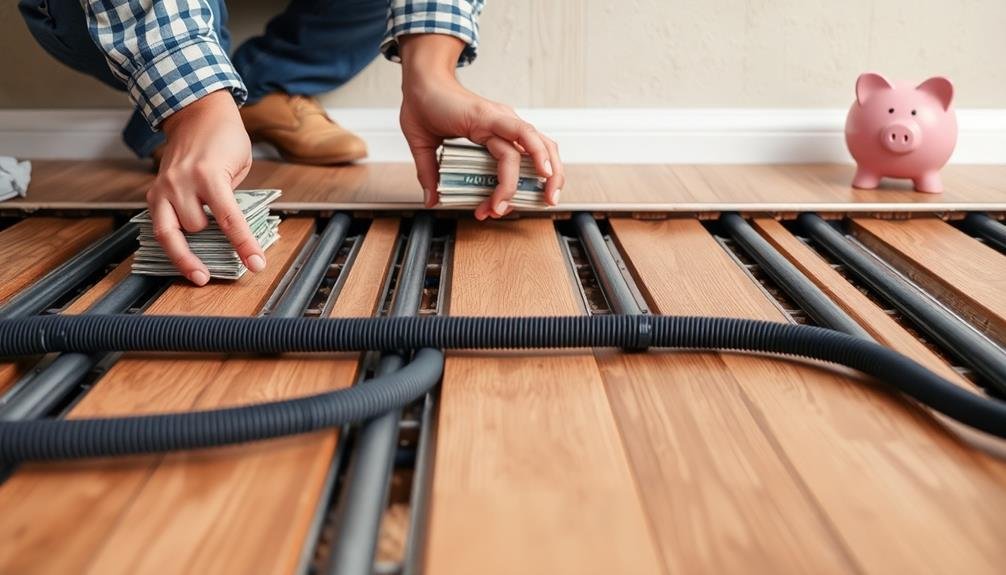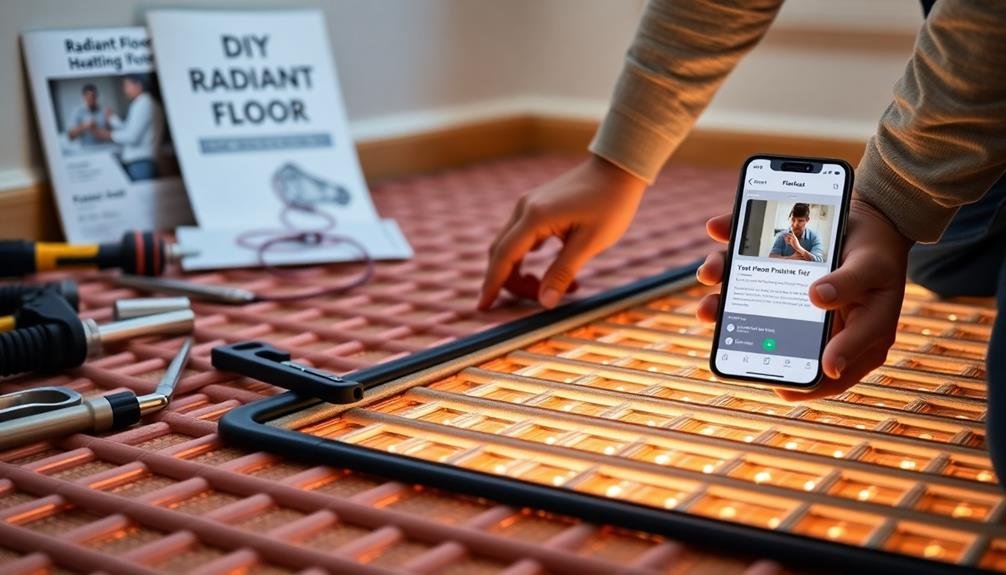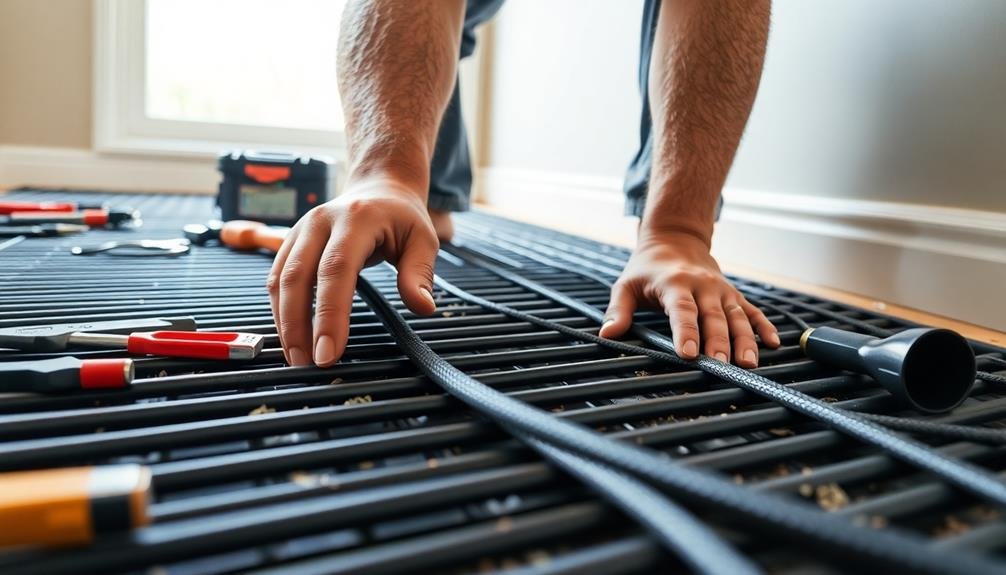Installing radiant floor heating yourself offers substantial benefits. You'll save 50-70% on labor costs and avoid contractor markups on materials. DIY installation gives you complete control over the system's design, allowing customization for your specific needs and preferences. You'll gain valuable home improvement skills, from electrical work to plumbing, enhancing your problem-solving abilities. By doing it yourself, you'll sidestep scheduling conflicts with contractors and work at your own pace. Plus, there's an immense sense of personal satisfaction in creating comfort with your own hands. The advantages of self-installation go far beyond just cost savings.
Cost Savings of DIY Installation

The cost savings of DIY radiant floor heating installation can be substantial. By tackling this project yourself, you'll eliminate labor costs, which typically account for 50-70% of the total installation expense. You'll only need to pay for materials, potentially saving thousands of dollars.
When you install radiant floor heating on your own, you have more control over material choices. You can shop around for the best deals on tubing, manifolds, and thermostats, further reducing your costs. Additionally, you won't have to pay for a contractor's markup on these materials.
DIY installation also allows you to work at your own pace, avoiding rush charges or overtime fees that professional installers might incur. You can schedule the project around your availability, potentially saving on costs associated with taking time off work.
By learning the installation process, you'll gain valuable knowledge for future maintenance and repairs. This expertise can save you money in the long run, as you won't need to call in professionals for minor issues or adjustments.
However, it's essential to weigh these cost savings against the time investment and potential risks of DIY installation. Make certain you're confident in your abilities before proceeding.
Customization for Your Specific Needs
When it comes to customization, DIY radiant floor heating installation offers unparalleled flexibility.
You'll have complete control over the system's design, allowing you to tailor it to your specific needs and preferences. Unlike pre-packaged solutions, you can choose the exact layout, heating zones, and temperature controls that work best for your home.
You're free to decide which rooms receive heating and to what extent. Perhaps you want extra warmth in the bathroom but less in the bedroom. With DIY installation, you can adjust the heating cable spacing to create these variations.
You'll also have the freedom to select the thermostat type and placement that suits your lifestyle.
DIY installation lets you work around unique architectural features or furniture layouts. You can easily accommodate irregularly shaped rooms, built-in fixtures, or planned future renovations.
Additionally, you can integrate the system with your existing home automation setup for seamless control.
Learning Valuable Home Improvement Skills

As you commence a DIY radiant floor heating installation, you'll gain far more than just a warm floor.
You'll develop a range of valuable home improvement skills that can serve you well in future projects. You'll learn about electrical systems, plumbing, and flooring techniques, giving you a thorough understanding of how these elements work together in your home.
Throughout the process, you'll become proficient in reading and interpreting technical diagrams and instruction manuals. This skill will prove invaluable for future DIY endeavors.
You'll also enhance your problem-solving abilities as you navigate challenges that inevitably arise during installation.
Working with tools specific to radiant heating systems will expand your toolkit and expertise. You'll learn to use specialized equipment like heat guns, crimping tools, and pressure testers.
These skills can translate to other home improvement projects, saving you money on future repairs or renovations.
Moreover, you'll gain confidence in your ability to tackle complex home improvement tasks.
This self-assurance can inspire you to take on more ambitious projects, further enhancing your home's value and functionality while saving on labor costs.
Avoiding Scheduling Conflicts With Contractors
Effective coordination is key when working with contractors during your radiant floor heating installation. When you're managing the project yourself, you'll need to juggle multiple professionals, including plumbers, electricians, and flooring specialists.
To avoid scheduling conflicts, create a detailed timeline and communicate it clearly to all parties involved. Be prepared to adjust your plans as unexpected issues arise, and always build in some buffer time between different stages of the project.
Keep in mind that contractors often have busy schedules, so book them well in advance. When possible, try to schedule overlapping work for different trades to maximize efficiency.
However, be careful not to overcrowd your work site, as this can lead to confusion and mistakes. Stay flexible and maintain open lines of communication with all contractors throughout the process.
- Feel the pride of successfully orchestrating a complex home improvement project
- Experience the satisfaction of saving money by managing contractors efficiently
- Enjoy the peace of mind that comes with being in control of your home's transformation
- Relish the excitement of watching your vision come to life without delays or setbacks
Personal Satisfaction of Self-Installation

The sense of accomplishment from installing your own radiant floor heating system is unparalleled. You'll feel a deep sense of pride every time you step onto your warm floors, knowing that you've created this comfort with your own hands.
It's not just about saving money; it's about the personal investment of time and effort that makes your home truly yours.
As you tackle each step of the installation process, you'll gain valuable skills and knowledge about your home's infrastructure. You'll understand how the system works from the ground up, making future maintenance easier.
This hands-on experience can be empowering, boosting your confidence in handling other home improvement projects.
There's also a unique satisfaction in customizing the system to your exact preferences. You can fine-tune the layout, zoning, and controls to perfectly suit your lifestyle.
When friends and family compliment your cozy floors, you'll have the pleasure of explaining how you made it happen. The sense of ownership and connection to your living space that comes from a DIY radiant floor heating installation is truly rewarding.
Frequently Asked Questions
How Long Does It Typically Take to Install Radiant Floor Heating?
You'll typically need 2-5 days to install radiant floor heating, depending on your room size and experience level. It's a time-consuming process that involves preparing the subfloor, laying tubing, and connecting the system to your heating source.
What Tools Are Necessary for a DIY Radiant Floor Heating Installation?
You'll need several tools for DIY radiant floor heating installation: a tubing uncoiler, manifold, thermostat, pressure tester, pipe cutter, staple gun, and PEX crimping tool. Don't forget safety gear like gloves and goggles.
Can Radiant Floor Heating Be Installed in Existing Homes?
Yes, you can install radiant floor heating in existing homes. You'll need to remove existing flooring and possibly raise floor levels. It's more challenging than new construction, but it's doable with proper planning and professional guidance.
Is Radiant Floor Heating Suitable for All Types of Flooring Materials?
You'll find radiant floor heating works with most flooring types. It's especially compatible with tile, stone, and concrete. However, you'll need to be cautious with wood and carpet, as they can act as insulators, reducing efficiency.
How Energy-Efficient Is Radiant Floor Heating Compared to Traditional Heating Systems?
You'll find radiant floor heating is typically more energy-efficient than traditional systems. It's up to 30% more efficient, as it heats objects directly rather than air. You'll lose less heat and enjoy more consistent warmth throughout your space.
In Summary
You've now seen the compelling reasons to install radiant floor heating yourself. You'll save money, tailor the system to your needs, and gain valuable skills. By avoiding contractor schedules, you'll complete the project on your timeline. Best of all, you'll feel a sense of pride every time you enjoy your warm floors. With careful planning and research, you can tackle this rewarding DIY project and reap the benefits for years to come.





Leave a Reply